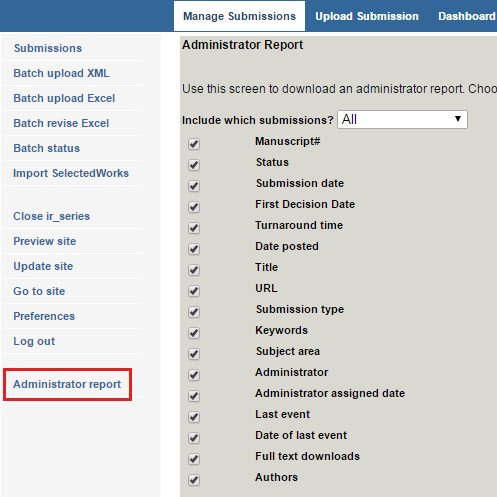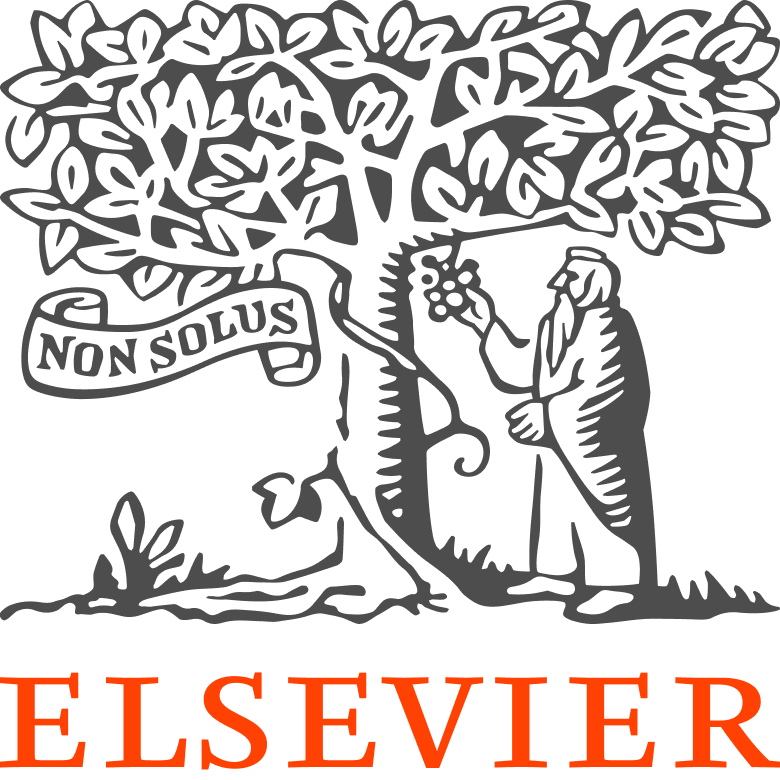How Can We Help?
Overview of Digital Commons ReportsOverview of Digital Commons Reports
In This Guide
This document introduces repository administrators and editors to the types of reports currently available for Digital Commons, and suggests some practical applications and uses of the report data. The following report options are described in this document:
- Usage reports for administrators
- Content reporting for administrators
- Submission management reports for editors and publication-level administrators
- Reports for authors
- Reports for institutional stakeholders
- Google Analytics
For questions or assistance with any of the options described in this guide, please don’t hesitate to contact Consulting Services.
Usage Reports for Administrators
Repository administrators have access to three types of on-demand usage reports within the Digital Commons Dashboard: Full Text Downloads, Full Text & Additional Files, and Metadata Page Hits.
Dashboard tools allow you to adjust the time frame and add filters to isolate content by publication type or discipline, or both. You’re also able to include collected content, such as items collected from one publication to another in the repository.
Any options you choose on the dashboard apply as you drill down to view statistics for specific collections or works. This allows both repository administrators and publication-level administrators or editors to explore readership of their content, then capture the results in an Excel spreadsheet.
In addition to usage reports, statistics may be quickly exported to CSV for other types of data available on the dashboard, including: readership by country and regional distribution of downloads; works posted within a given time frame; PlumX Metrics; and institutions where materials have been accessed.
To access the Digital Commons Dashboard: Visit https://dashboard.bepress.com and log in, or start from your My Account page and click Digital Commons Dashboard. Administrators with the permission to see reports are able to access the dashboard. If you are a site administrator and wish to provide dashboard access to a journal editor, series administrator, or conference organizer, please contact Consulting Services to ensure the correct permissions are in place.
For more information: Find full details in the Digital Commons Dashboard guide.
Content Reporting for Administrators
If you need to analyze the content and metadata across your repository, or zoom in on specific collections, the Content Reporting Tool provides a comprehensive spreadsheet that includes all published or pending items.
For more information: See the Content Reporting Tool guide.
Submission Management Reports for Editors
An editor/administrator report for tracking editorial statistics is available for any individual publication (such as a series or journal) from the sidebar of the Manage Submissions tab. Depending on the publication, the sidebar option will say either “Administrator Report” or “Editor Report.”
Administrators can run this report by selecting the sidebar option, choosing the fields for which they would like data, and clicking the “Report” button at the bottom of the screen. This will generate a spreadsheet listing the selected data.
These reports provide the data to assess acceptance rate, turnaround time, editor workload, and other information about submissions made to the publication structure. Editors have the option to run the report for all submissions in the publication, or to filter the results by the current state of the submissions (Not yet published, Queued for update, Published, Rejected, or Withdrawn).
Editor reports are particularly useful for administrators of publications with many participants, and for editors of journals that have many associate editors and reviewers. For example, an editor report would be useful to an editor-in-chief who wants to compare other editors’ workloads and assess the amount of time it takes for a submitted article to be published. The report would allow the editor to generate a spreadsheet detailing this information for each submission to the journal.

Submission management reports are most commonly used by journal editors who need to keep track of editorial workflows. Read more about working with Digital Commons journals in Managing and Publishing Journals.
Reports for Authors
Author Dashboard
The Author Dashboard is a personalized reporting tool for authors in Digital Commons available via each author’s My Account page. The Author Dashboard allows authors to view download counts in real time, learn where their work was downloaded around the world, and discover from which institutions their work was accessed.
For more information: See the Author Dashboard guide.
Automatic Monthly Author Readership Report
Monthly emails are delivered automatically to authors’ inboxes. These reports detail combined download counts for all of the author’s full-text articles published to the repository. Monthly Author Readership Reports also contain a link to the Author Dashboard, which provides detailed statistics about the author’s published work.
For an author to receive the monthly email, their email address must be included in the author metadata with the submission, and the paper needs to have been downloaded at least once in the month prior to the delivery of the email.
Adding author emails to publications in the repository is an easy way for an IR administrator to keep the repository on the faculty’s radar and increase engagement. IR administrators who routinely include author email addresses in article metadata observe that interest in the IR increases once authors begin receiving Author Readership Reports.
Reports for Institutional Stakeholders
Sharing the Digital Commons Dashboard
The Digital Commons Dashboard offers the ability to share views of the data on your dashboard, making it easy to demonstrate impact and highlight stories to stakeholders. Guest access links allow users to see an “initial view” that you’ve chosen, with no login required. Users are then free to explore the rest of the dashboard except for your administrative tools and share links. You’re able to track the number of views for each guest access link and you can deactivate a link at any time.
If you’d prefer to send a file to stakeholders, dashboard usage reports described in the beginning of this guide allow you to share statistics in an Excel spreadsheet. Reports are available for downloads and metadata page hits, and each includes options for fine-tuning report contents. Most other dashboard components offer an export option to download and disseminate information such as the regional distribution of repository usage.
In addition, PlumX Metrics are integrated right into the Digital Commons Dashboard, allowing you to access a variety of relevant metrics all in one place. You can easily combine insights from usage, alternative metrics, and citation counts to export and highlight in stakeholder reports across a broad range of disciplines.
Access the dashboard at https://dashboard.bepress.com, and read more about features in the Digital Commons Dashboard guide.
Monthly Activity Reports
Digital Commons also provides a monthly reporting email for institutional stakeholders, similar to our Monthly Author Readership Report emails. The IR Activity Summary Email and the Publication Activity Summary Email are intended to deliver usage statistics and reports to stakeholders at the institution who might not interact with the repository directly, and to encourage content growth by reminding them of the IR’s monthly progress.
Department chairs, research center staff, deans, and people involved with funding are all good examples of stakeholders for whom these emails can provide a compelling snapshot of collection growth.
Monthly activity reports are sent to administrators who have the “View Digital Commons Dashboard” permission, which also grants the ability to run usage reports. You may enable this permission for any administrator or editor who wishes to receive monthly reports. To give a stakeholder access to run usage reports and receive activity summary emails without having other administrator permissions, add that person as an administrator and only select the “View Digital Commons Dashboard” permission. See Managing Administrator Permissions for more information.
IR Activity Summary Email:
This email report provides general information about site readership for the entire repository. The report includes:
- The number of full-text downloads for the IR in the past month
- The number of new submissions posted to the IR in the past month
- The three most popular papers
- The three most popular publications
- The total number of records on the IR
- The total number of downloads of items on the IR
- A link to the Usage Reports interface for the IR
The IR Activity Summary email is sent to those stakeholders who have access to usage reports at the site level.
Publication Activity Summary Email:
This email report provides general information about site readership for individual publications within the repository. The report includes:
- A link to the user’s My Account page to allow for usage reports to be run on any publication where the user has the relevant permissions
- The number of full-text downloads for the publication in the past month
- The number of new submissions posted to the publication in the past month
- The three most popular papers in the publication
- A link to the Usage Reports interface for the publication
The Publication Activity Summary email is sent to those stakeholders who have access to usage reports at the publication level, but not the site level. If a stakeholder has access to usage reports for multiple publications, the publication summaries will be combined into a single email.
Google Analytics: Additional Options for Tracking Usage of Your Content
Google Analytics can be implemented by request on your Digital Commons repository. The reports can be accessed by logging in at https://analytics.google.com/, once your tracking code has been added by Consulting Services. Contact your consultant if you would like to set this up or have access difficulties once implemented.
Google Analytics complements Digital Commons usage reports by providing users information about traffic to repository pages and helping to identify general trends in traffic over time. The tools are useful for learning where repository visitors come from, which browsers they use, and which pages they visit.
Google™ support documents can aid IR administrators in the exploration of functionality. The Consulting Services team can point users to those resources.
For more information, please see Q&A on Digital Commons and Google Analytics (PDF), or contact Consulting Services.
Frequently Asked Questions
Why am I receiving two reports?
If you receive two copies of the monthly report emails, you may have multiple accounts in the system. Please check the email address that the reports are being sent to and contact your consultant for assistance.
How do the numbers for different reports compare?
Please see DC Reporting Tools At a Glance (PDF) which includes a summary of some common differences and what may cause them. For specific questions about the numbers in any of your reports, please contact Consulting Services.
Can we find the number of queries to the repository for ARL reporting?
Administrators can find this information via Google Analytics. If you would like assistance, please contact your consultant.
Is it possible to find out which search terms are popular and driving traffic to the repository?
Google Analytics may provide some information about search terms that are driving traffic to the repository, which may help you populate the site with the right keywords. However, be wary of keyword stuffing and try to follow SEO best practices.
 Digital Commons Help Center
Digital Commons Help Center